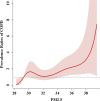The effects of traffic-related air pollutants on chronic obstructive pulmonary disease in the community-based general population
- PMID: 34344356
- PMCID: PMC8336021
- DOI: 10.1186/s12931-021-01812-x
The effects of traffic-related air pollutants on chronic obstructive pulmonary disease in the community-based general population
Abstract
Background: Previous studies have shown inconsistent results regarding the impact of traffic pollution on the prevalence of chronic obstructive pulmonary disease (COPD). Therefore, using frequency matching and propensity scores, we explored the association between traffic pollution and COPD in a cohort of 8284 residents in a major agricultural county in Taiwan.
Methods: All subjects completed a structured questionnaire interview and health checkups. Subjects with COPD were identified using Taiwan National Health Insurance Research Databases. A hybrid kriging/LUR model was used to identify levels of traffic-related air pollutants (PM2.5 and O3). Multiple logistic regression models were used to calculate the prevalence ratios (PRs) of COPD and evaluate the role played by traffic-related indices between air pollutants and COPD. The distributed lag nonlinear model was applied in the analysis; we excluded current or ever smokers to perform the sensitivity analysis.
Results: Increased PRs of COPD per SD increment of PM2.5 were 1.10 (95% CI 1.05-1.15) and 1.25 (95% CI 1.13-1.40) in the population with age and sex matching as well as propensity-score matching, respectively. The results of the sensitivity analysis were similar between the single and two pollutant models. PM2.5 concentrations were significantly associated with traffic flow including sedans, buses, and trucks (p < 0.01). The higher road area and the higher PM2.5 concentrations near the subject's residence correlated with a greater risk of developing COPD (p for interaction < 0.01).
Conclusions: Our results suggest that long-term exposure to traffic-related air pollution may be positively associated with the prevalence of COPD.
Keywords: Air pollution; Chronic obstructive pulmonary disease; Land-use regression model; O3; PM2.5.
© 2021. The Author(s).
Conflict of interest statement
The authors declare no conflicts of interest.
Figures



Similar articles
-
Effects of long-term exposure to traffic-related air pollution on respiratory and cardiovascular mortality in the Netherlands: the NLCS-AIR study.Res Rep Health Eff Inst. 2009 Mar;(139):5-71; discussion 73-89. Res Rep Health Eff Inst. 2009. PMID: 19554969
-
The London low emission zone baseline study.Res Rep Health Eff Inst. 2011 Nov;(163):3-79. Res Rep Health Eff Inst. 2011. PMID: 22315924
-
Effect of long-term exposure to fine particulate matter on lung function decline and risk of chronic obstructive pulmonary disease in Taiwan: a longitudinal, cohort study.Lancet Planet Health. 2018 Mar;2(3):e114-e125. doi: 10.1016/S2542-5196(18)30028-7. Epub 2018 Mar 2. Lancet Planet Health. 2018. PMID: 29615226
-
Relationship between fine particulate matter (PM2.5) concentration and risk of hospitalization due to chronic obstructive pulmonary disease: a systematic review and meta-analysis.BMC Public Health. 2023 Nov 13;23(1):2229. doi: 10.1186/s12889-023-17093-6. BMC Public Health. 2023. PMID: 37953239 Free PMC article.
-
Impact of long-term exposure to ambient air pollution on the incidence of chronic obstructive pulmonary disease: A systematic review and meta-analysis.Environ Res. 2021 Mar;194:110703. doi: 10.1016/j.envres.2020.110703. Epub 2021 Jan 6. Environ Res. 2021. PMID: 33417909
Cited by
-
Factors influencing the prevalence and death rate of COPD: a pan-database ecological study covering 201 countries and regions from 1990 to 2021.EClinicalMedicine. 2025 Aug 1;86:103347. doi: 10.1016/j.eclinm.2025.103347. eCollection 2025 Aug. EClinicalMedicine. 2025. PMID: 40791891 Free PMC article.
-
Mechanisms of Lung Damage and Development of COPD Due to Household Biomass-Smoke Exposure: Inflammation, Oxidative Stress, MicroRNAs, and Gene Polymorphisms.Cells. 2022 Dec 23;12(1):67. doi: 10.3390/cells12010067. Cells. 2022. PMID: 36611860 Free PMC article. Review.
-
Urban air pollution and chronic respiratory diseases in adults: insights from a cross-sectional study.Front Public Health. 2025 Mar 12;13:1507882. doi: 10.3389/fpubh.2025.1507882. eCollection 2025. Front Public Health. 2025. PMID: 40145001 Free PMC article.
-
The Effects and Pathogenesis of PM2.5 and Its Components on Chronic Obstructive Pulmonary Disease.Int J Chron Obstruct Pulmon Dis. 2023 Apr 6;18:493-506. doi: 10.2147/COPD.S402122. eCollection 2023. Int J Chron Obstruct Pulmon Dis. 2023. PMID: 37056681 Free PMC article. Review.
-
Joint effects of temperature and humidity with PM2.5 on COPD.BMC Public Health. 2025 Feb 3;25(1):424. doi: 10.1186/s12889-025-21564-3. BMC Public Health. 2025. PMID: 39901163 Free PMC article.
References
-
- Leclercq B, Kluza J, Antherieu S, Sotty J, Alleman LY, Perdrix E, Loyens A, Coddeville P, Lo Guidice JM, Marchetti P, et al. Air pollution-derived PM2.5 impairs mitochondrial function in healthy and chronic obstructive pulmonary diseased human bronchial epithelial cells. Environ Pollut. 2018;243(Pt B):1434–49. doi: 10.1016/j.envpol.2018.09.062. - DOI - PubMed
-
- Andersen ZJ, Hvidberg M, Jensen SS, Ketzel M, Loft S, Sorensen M, Tjonneland A, Overvad K, Raaschou-Nielsen O. Chronic obstructive pulmonary disease and long-term exposure to traffic-related air pollution: a cohort study. Am J Respir Crit Care Med. 2011;183(4):455–461. doi: 10.1164/rccm.201006-0937OC. - DOI - PubMed
MeSH terms
Substances
LinkOut - more resources
Full Text Sources
Medical

